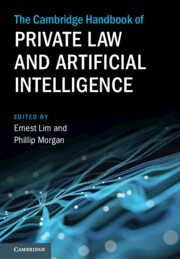Book contents
- The Cambridge Handbook of Private Law and Artificial Intelligence
- Reviews
- The Cambridge Handbook of Private Law and Artificial Intelligence
- Copyright page
- Dedication
- Contents
- Figures
- Table
- Contributors
- Acknowledgements
- Abbreviations
- Introduction
- 1 AI for Lawyers
- 2 Computable Law and AI
- Part I Law of Obligations
- Part II Property
- Part III Corporate and Commercial Law
- Part IV Comparative Perspectives
- 27 Data Protection in EU and US Laws and AI
- 28 Legal Personhood and AI
- 29 EU and AI
- Index
28 - Legal Personhood and AI
AI Personhood on a Sliding Scale
from Part IV - Comparative Perspectives
Published online by Cambridge University Press: 21 March 2024
- The Cambridge Handbook of Private Law and Artificial Intelligence
- Reviews
- The Cambridge Handbook of Private Law and Artificial Intelligence
- Copyright page
- Dedication
- Contents
- Figures
- Table
- Contributors
- Acknowledgements
- Abbreviations
- Introduction
- 1 AI for Lawyers
- 2 Computable Law and AI
- Part I Law of Obligations
- Part II Property
- Part III Corporate and Commercial Law
- Part IV Comparative Perspectives
- 27 Data Protection in EU and US Laws and AI
- 28 Legal Personhood and AI
- 29 EU and AI
- Index
Summary
Whether AI should be given legal personhood should not be framed in binary terms. Instead, this issue should be analysed in terms of a sliding-scale spectrum. On one axis, there is the quantity and quality of the bundle of rights and obligations that legal personhood entails. The other axis is the level of the relevant characteristics that courts may include in conferring legal personhood.
- Type
- Chapter
- Information
- Publisher: Cambridge University PressPrint publication year: 2024

